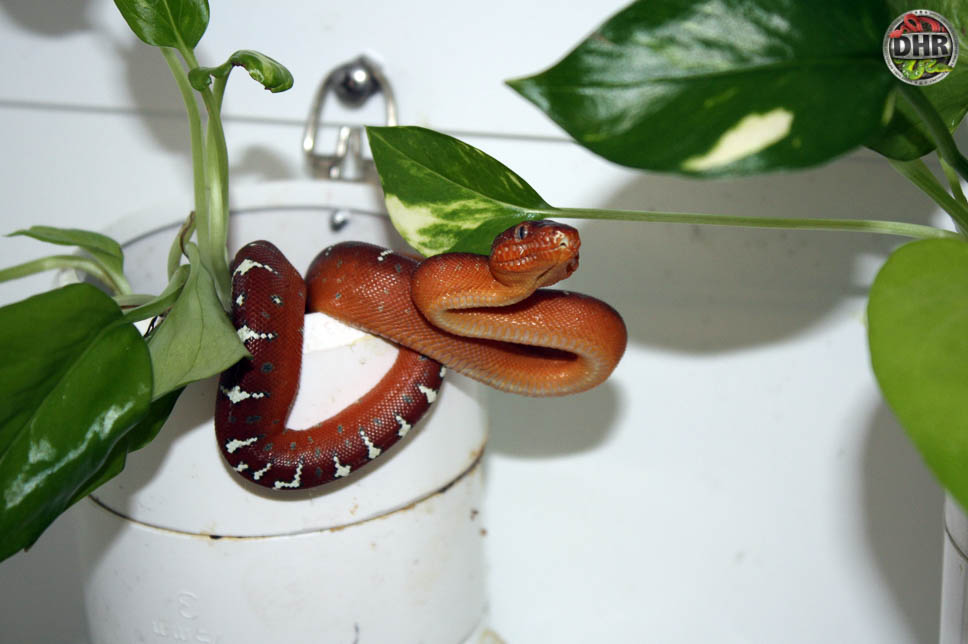The Northern Emerald Tree Boa (Corallus caninus) is a non-venomous reptile species belonging to the family Boidae. It is known for its striking emerald-green coloration and arboreal lifestyle. Below is the requested information about the Northern Emerald Tree Boa:
Synonym
- Corallus caninus (LINNAEUS, 1758)
Common Names
- Northern Emerald Tree Boa
- Amazon Tree Boa
- Green Tree Boa
Natural Distribution
The Northern Emerald Tree Boa is native to Central and South America. Its range includes the northern region of Colombia, Brazil, and from Venezuela to Suriname and the Guianas within the so-called Guiana Shield.
Conservation Status
- CITES appendix II
- Least concern (LC)
The Northern Emerald Tree Boa (Corallus caninus) is listed as a species of “Least Concern” by the International Union for Conservation of Nature (IUCN).
However, the Convention on International Trade (CITES) in Endangered Species of Wild Fauna and Flora lists all BOIDAE subspecies (except the species included in Appendix I) as Appendix II. This includes species not necessarily threatened with extinction, but in which trade must be controlled in order to avoid utilization incompatible with their survival.
Characteristics
Size: Adult Northern Emerald Tree Boas are typically between 5 to 7 feet (1.5 to 2.1 meters) in length, with females generally being larger than males.
Coloration: These boas have a vibrant emerald green coloration on their dorsal (upper) side, which provides excellent camouflage in the rainforest canopy. The ventral (underside) side is usually cream or pale yellow.
Body Shape: They have a robust body with a prehensile tail, allowing them to grip branches and move adeptly through the trees.
Scales: The scales of the Northern Emerald Tree Boa are smooth and iridescent, enhancing their overall appearance.
Head and Eyes: They have a distinct triangular-shaped head and large eyes with vertical pupils.
Northern Emeralds are distinguishable from other species in the complex (except Corallus batesii) by their green dorsal background color with white markings dorsally. The background green can range from a dark forest green to a light “Emerald” green, while the white markings can be quite prominent or nearly devoid1.
Neonates are born brick red, as a natural deterrent to predators, gradually turning green in the first years of age.
Northern Emerald Tree Boa Gallery














References
- Emerald Tree Boa, Corallus caninus, The International Union for Conservation of Nature (IUCN) (accessed online 2023).
- McDiarmid, R. W., Campbell, J. A., & Touré, T. A. (1999). Snake Species of the World: A Taxonomic and Geographic Reference. Vol. 1. Herpetologists’ League.
- Bartlett, R. D., & Bartlett, P. (2003). Green Tree Pythons and Emerald Tree Boas: Reptile and Amphibian Keeper’s Guide. Barron’s Educational Series.
- Corallus caninus. (2021). The Reptile Database. Retrieved from https://reptile-database.reptarium.cz/species?genus=Corallus&species=caninus
- Corallus caninus (LINNAEUS, 1758) – The Reptile Database (Accessed Online 2017)
- Geographic Variation in the Emerald Tree Boa, Corallus caninus (Squama Boidae) Henderson et. al. 2009
- Convention on International Trade in Endangered Species of Wild Fauna and Flora (CITES) – Appendices I, II and III (Accessed Online, 2017)
